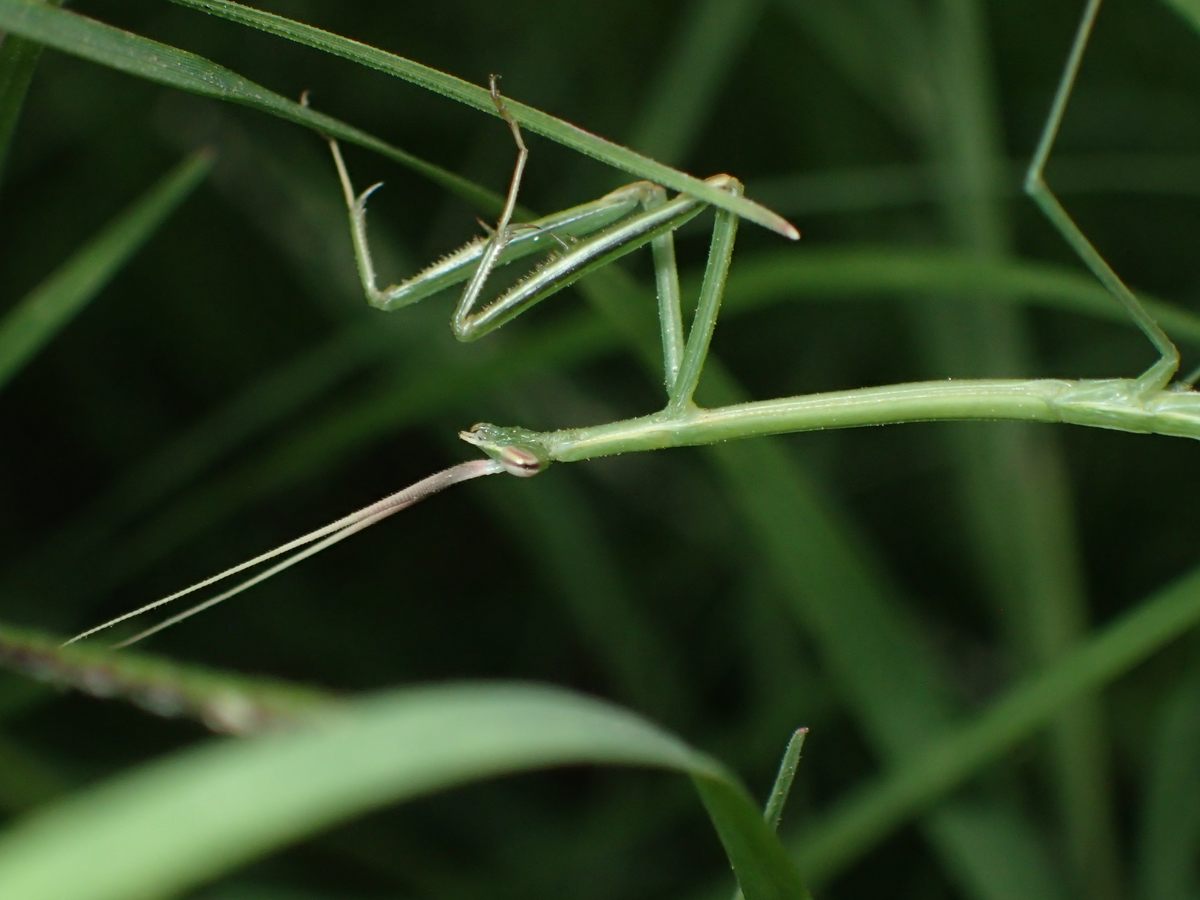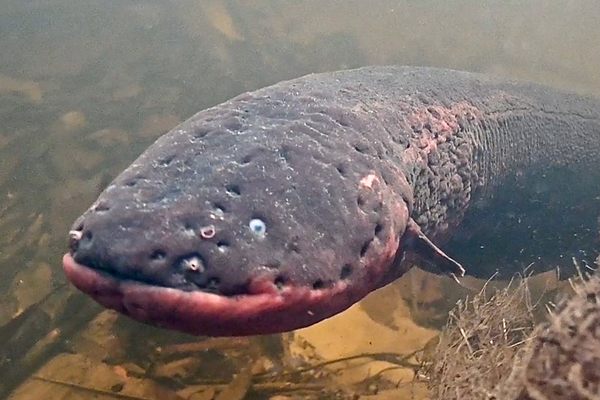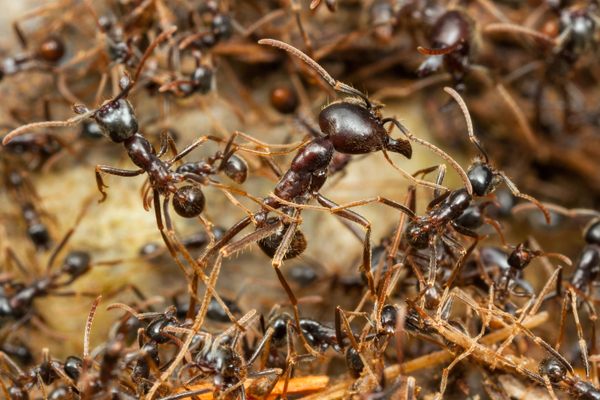The Mystery of Uruguay’s Ferocious, All-Female Cannibal Insects
The small-winged stick mantis is found throughout South America’s grasslands. But in Uruguay, the population is entirely female.
A tribe of ferocious, cannibalistic Amazons lurks in the grasslands of southern Uruguay. Ok, they’re not the notorious warrior women of myth: They’re only a few inches long and they can’t fire an arrow. But they are no less wondrous, especially to researcher Mariana Trillo, who discovered this unique population of praying mantises and has studied them ever since.
Growing up in the suburbs of Montevideo, Trillo had always wanted to study biology but discovered an unexpected passion late in her university program. “The insects and arachnids won me over because of their strangeness and their sexual behavior. Praying mantises were the most interesting of them all,” she says.
After graduation, Trillo went to work documenting all of Uruguay’s mantis species, starting with specimens collected over half a century ago and stored in the natural history archive of the Universidad de la República. As she examined drawer after drawer of desiccated insects, something caught Trillo’s attention. The small-winged stick mantis (Brunneria subaptera) is a species with a wide distribution across the grasslands of South America. However, as Trillo discovered, “All of the 250 specimens collected in Uruguay were female; there weren’t any males. It was weird.”
In 2017, driven by curiosity, Trillo embarked on a yearlong field study, collecting live specimens across the Uruguayan savanna, the now-fragmented natural habitat of the species. She wanted to know whether the patterns she’d seen in the archive were coincidence or evidence of something much stranger.
Trillo and her colleagues combed through the grassland, catching the insects by hand near sunset, when they’re most active, and bringing them back to the lab. There they were able to observe the life cycle of the pint-sized predator, which is an expert hunter from the moment it hatches.
The life of a small-winged stick mantis is brief—a year at most, if it is exceptionally lucky—and it’s spent ceaselessly stalking prey among the blades of grass. After ambushing and grabbing its quarry with its barbed forelimbs, the mantis devours them alive, headfirst. Flies, grasshoppers, bees, and butterflies make up the usual fare but, when the occasion arises, other mantises are definitely on the menu. “When you do fieldwork to collect this species, you see a lot of cannibalism,” says Trillo.
The majority of praying mantis species, including B. subaptera, are well known for sexual cannibalism: Females devour their mates shortly after or even during mating. But among Uruguay’s B. subaptera populations, Trillo quickly discovered there were no males of the species for females to mate with, let alone turn into a post-coital snack.
All of the specimens she and colleagues collected were female. Observing the juvenile mantis “virgins,” as Trillo calls them, the team watched the insects mature and then lay egg sacs, which hatched into hundreds of offspring—many of which began snacking on their siblings.
“We’d already been expecting it, but it was still incredible to see,” Trillo says. “We had conclusive proof that the Uruguayan population of this species was parthenogenetic.”

In the reproductive strategy known as thelytoky, or thelytokous parthenogenesis, females produce eggs that are essentially clones of the mother and don’t require male sperm to be fertilized. Once the eggs hatch and the female clones emerge, the cycle repeats. Rare in vertebrates except for a handful of fish, reptile, and amphibian species, thelytoky is more common among invertebrates and offers many benefits.
“Insects that reproduce via thelytoky don’t have to waste time or energy finding a male. They get to avoid physical costs that are often associated with mating, and they have increased colonization ability. It only takes one female to create a new population,” says Soleille Miller, a researcher at the University of New South Wales who has studied parthenogenesis in the peppermint stick insect.
As part of her research, Trillo visited the pampas in neighboring Argentina to take DNA samples of local B. subaptera populations for comparison with those from Uruguay. She remembers being struck, quite literally, by the differences. Only male small-winged stick mantises are able to fly and, she says, in Argentina, “the males are everywhere. You’d go out into the grasslands at night, and they are drawn to your headlamp, flying in your face and crawling all over you.”
Back in the lab, however, analysis of the samples collected revealed that the Argentine and Uruguayan populations were essentially the same, with no significant genetic differences.
Trillo and her team hunted for the reason why the Uruguayan populations were parthenogenetic. One suspect early on in their work: the parasitic bacteria Wolbachia. The parasite can trigger parthenogenesis in infected insects, which can allow it to spread more widely. However, tests showed that none of the praying mantises had been infected.

That left one probable explanation: geographic parthenogenesis, when a regional population develops asexual reproduction due to environmental factors. Miller says there are a few reasons geographic parthenogenesis occurs.
“It could possibly be due to females dispersing further than males in some species,” Miller says, adding that parthenogenesis can also enable the animals to colonize habitats that are marginal or extreme through “populations of clones that are highly specialized for specific environments.”
While Trillo and her team have yet to pinpoint the underlying trigger for the Uruguayan population’s parthenogenesis, they have their suspicions. “We’re famous for our grasslands, but these aren’t pristine ecosystems anymore. They’ve shrunk and been heavily modified by centuries of agriculture and urbanization, so parthenogenesis may be a response to human impacts, “ says evolutionary biologist Anita Aisenberg, Trillo’s supervisor. It’s also possible, she adds, that the insects’ asexual reproduction evolved naturally, reflecting that Uruguay is what she calls an “ecological crossroads” between different grassland environments.
Trillo continues her efforts to decipher the secrets of Uruguay’s tiniest Amazons. Her sharp attention to detail, which uncovered the all-female population in the first place, speaks to a larger pattern when studying the country’s biodiversity, according to Aisenberg.
Aisenberg works with other young biologists in Uruguay, many of whom are women. She says colleagues from some neighboring countries, where the field is male-dominated, often joke about how “strange” Uruguay’s insects are. Aisenberg believes, however, that the country’s critters might not be particularly unusual; instead, women might simply be better at picking up on anomalies, and more open-minded and curious about exploring the possibilities. Much like, perhaps, a female praying mantis venturing further afield, trusting that life finds a way.





















Follow us on Twitter to get the latest on the world's hidden wonders.
Like us on Facebook to get the latest on the world's hidden wonders.
Follow us on Twitter Like us on Facebook